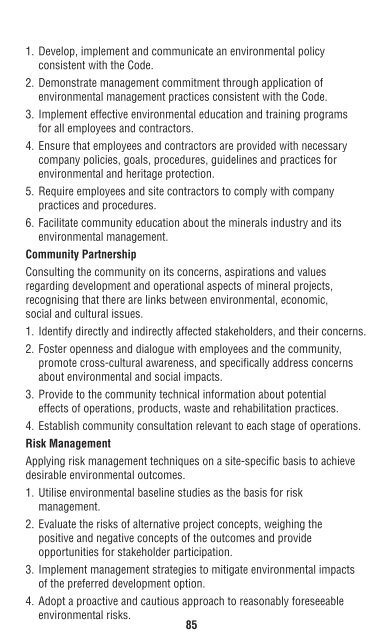Mine Rehabilitation Handbook - Mining and Blasting
Mine Rehabilitation Handbook - Mining and Blasting
Mine Rehabilitation Handbook - Mining and Blasting
You also want an ePaper? Increase the reach of your titles
YUMPU automatically turns print PDFs into web optimized ePapers that Google loves.
1. Develop, implement <strong>and</strong> communicate an environmental policy<br />
consistent with the Code.<br />
2. Demonstrate management commitment through application of<br />
environmental management practices consistent with the Code.<br />
3. Implement effective environmental education <strong>and</strong> training programs<br />
for all employees <strong>and</strong> contractors.<br />
4. Ensure that employees <strong>and</strong> contractors are provided with necessary<br />
company policies, goals, procedures, guidelines <strong>and</strong> practices for<br />
environmental <strong>and</strong> heritage protection.<br />
5. Require employees <strong>and</strong> site contractors to comply with company<br />
practices <strong>and</strong> procedures.<br />
6. Facilitate community education about the minerals industry <strong>and</strong> its<br />
environmental management.<br />
Community Partnership<br />
Consulting the community on its concerns, aspirations <strong>and</strong> values<br />
regarding development <strong>and</strong> operational aspects of mineral projects,<br />
recognising that there are links between environmental, economic,<br />
social <strong>and</strong> cultural issues.<br />
1. Identify directly <strong>and</strong> indirectly affected stakeholders, <strong>and</strong> their concerns.<br />
2. Foster openness <strong>and</strong> dialogue with employees <strong>and</strong> the community,<br />
promote cross-cultural awareness, <strong>and</strong> specifically address concerns<br />
about environmental <strong>and</strong> social impacts.<br />
3. Provide to the community technical information about potential<br />
effects of operations, products, waste <strong>and</strong> rehabilitation practices.<br />
4. Establish community consultation relevant to each stage of operations.<br />
Risk Management<br />
Applying risk management techniques on a site-specific basis to achieve<br />
desirable environmental outcomes.<br />
1. Utilise environmental baseline studies as the basis for risk<br />
management.<br />
2. Evaluate the risks of alternative project concepts, weighing the<br />
positive <strong>and</strong> negative concepts of the outcomes <strong>and</strong> provide<br />
opportunities for stakeholder participation.<br />
3. Implement management strategies to mitigate environmental impacts<br />
of the preferred development option.<br />
4. Adopt a proactive <strong>and</strong> cautious approach to reasonably foreseeable<br />
environmental risks.<br />
85<br />
5. Develop <strong>and</strong> implement contingency plans to address incidents <strong>and</strong><br />
abnormal operating <strong>and</strong> environmental conditions.<br />
Integrated Environmental Management<br />
Recognising environmental management as a corporate priority <strong>and</strong><br />
integrating environmental management into all operations from<br />
exploration, through design <strong>and</strong> construction to mining, minerals<br />
processing, rehabilitation <strong>and</strong> decommissioning.<br />
1. Establish a management system which allocates management <strong>and</strong><br />
employee responsibilities relevant to the organisation’s activities <strong>and</strong><br />
applicable legal requirements.<br />
2. Address within an environmental management system:<br />
- applicable legal <strong>and</strong> regulatory requirements;<br />
- requirements under this Code <strong>and</strong> any other codes to which the<br />
company is a signatory;<br />
- company environmental policies, objectives <strong>and</strong> targets;<br />
- environmental management plans <strong>and</strong> procedures;<br />
- environmental monitoring procedures;<br />
- setting <strong>and</strong> testing of contingency <strong>and</strong> emergency response plans;<br />
- regular auditing of the environmental management system <strong>and</strong><br />
environmental performance;<br />
- reporting procedures.<br />
3. Periodically review the environmental management system to ensure<br />
that it remains effective <strong>and</strong> relevant to the company’s evolving<br />
needs <strong>and</strong> changing community values <strong>and</strong> expectations.<br />
Performance Targets<br />
Setting environmental performance targets not necessarily limited to<br />
legislation, licence <strong>and</strong> permit requirements.<br />
1. Identify legal <strong>and</strong> other requirements applicable to the environmental<br />
aspects of the organisation’s activities, products or services.<br />
2. Set internal performance targets <strong>and</strong> periodically assess<br />
achievements to reinforce policy commitments <strong>and</strong> to enable<br />
demonstration of continual improvement.<br />
3. Ensure that legal requirements <strong>and</strong> internal performance targets are<br />
effectively communicated to the employees who are accountable for<br />
the relevant activities.<br />
86
















